Blackbirds, or Icterids, are a family of small to medium-sized, often colorful, New World passerines. Almost all species of blackbirds have black plumage; some blackbirds also have the added color blue on their heads.
When talking about blackbirds, the International Ornithological Committee (IOC) recognizes 109 species.
Out of 109 blackbird species, only 3 of them have blue heads. Those are the black oropendola, the shiny cowbird, and the common grackle.
Other black birds that have blue heads are purple sunbirds, purple martins, rooks, tree swallows, Asian fairy-bluebirds, blue-black grassquits, satin bowerbirds, blue-black grosbeaks, shining honeycreepers, blue buntings, blue-black kingfishers, and brown sicklebills.
Here are their photos and some fun facts about them.
Table of Contents
Black Birds With Blue Heads
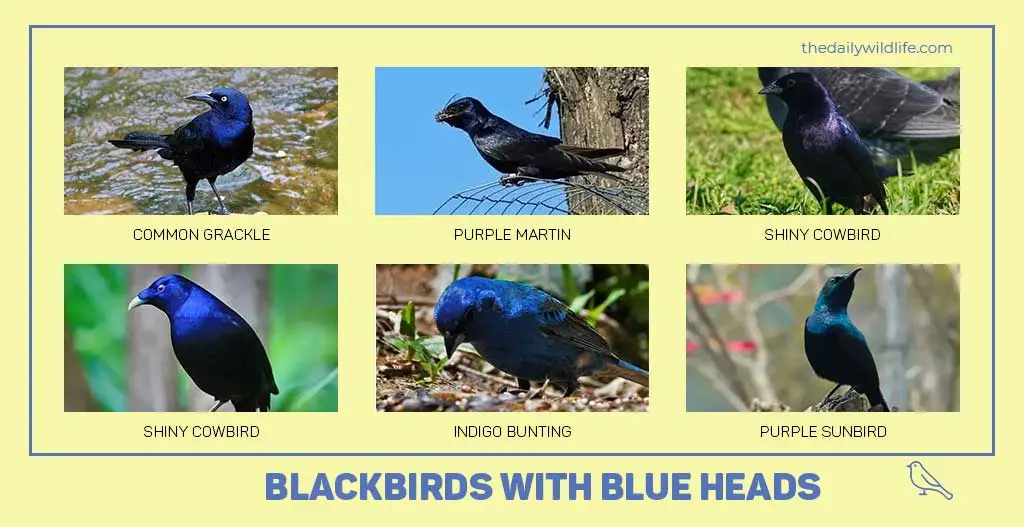
1. Common Grackle
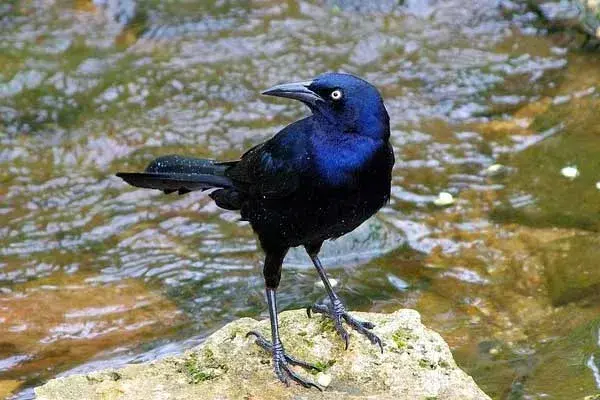
- Scientific name: Quiscalus quiscula
- Lifespan: 17-22 years
- Wingspan: 14-18 in
- Native to: North America
The common grackle, the most famous of all the blackbirds with blue heads, is a medium-sized songbird found in large numbers throughout North America.
It is easy to recognize by its long, keel-shaped tail, dark beak, yellow eyes, and (in males) glossy black plumage with a sheen blue-green head color.
Common grackles have a population of over 70 million individuals and can be found in wet, open woodlands, and marshes, as well as suburbs, parks, and agricultural fields.
They are short-distance migrants that breed across North America east of the Rocky Mountains.
Common grackles are omnivores and feed on insects, minnows, frogs, eggs, berries, seeds, and grain.
They will let ants crawl up their bodies and clean them from parasites. If no ants are available, grackles will use lemons, walnut juice, and mothballs for that purpose.
In several US countries, including Texas, it is illegal to kill grackles.
2. Black Oropendola
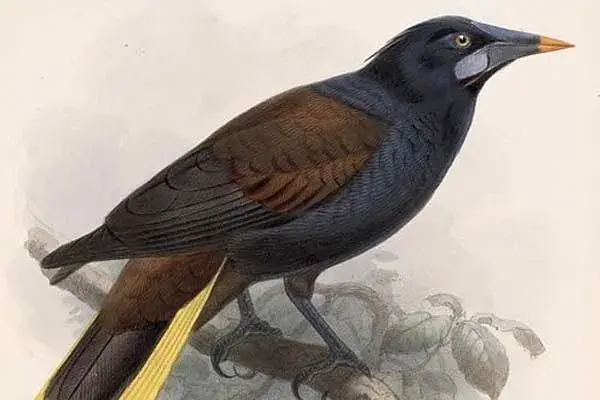
- Scientific name: Psarocolius guatimozinus
- Lifespan: 20 years
- Wingspan: n/a
- Native to: South America
The black oropendola is a large bird, a member of the family Icteridae (New World blackbirds). It is found in the subtropical and tropical lowland forests of Colombia and Panama.
It has an overall black plumage, dark brown back and wings, and a dark blue, indigo-colored head. Black oropendola has an orange-tipped beak with a large patch of blue skin at the base. Males and females look pretty much the same.
Black oropendolas are omnivores that feed on insects, small vertebrates, and fruit. They nest colonially, where over 20 birds might build their nest in one tree. Black oropendola’s eggs are pale pink.
3. Shiny Cowbird

- Scientific name: Molothrus bonariensis
- Lifespan: n/a
- Wingspan: 11 in
- Native to: South America
The shiny cowbirds are sleek-looking medium-sized birds; females closely resemble the brown-headed cowbirds. They are common in the Caribbean and South America and can be found around livestock, in semiopen and open grassy areas. Shiny cowbirds can be also found in Southern Florida, although it is uncommon.
Shiny Cowbird males have glossy violet-blue-black plumage, greenish-blue wings and tails, and a pointy blackish bill.
These birds are brood parasites that will lay their eggs in another bird’s nest and rely on it to rear their chicks.
Male shiny cowbirds are very aggressive towards other birds and their own kind – this includes behaviors like the “head-forwards threat”, “bill-tilt display”, physical breast-to-breast contacts, and chasings.
They are omnivores that feed on insects and seeds.
4. Purple Sunbird
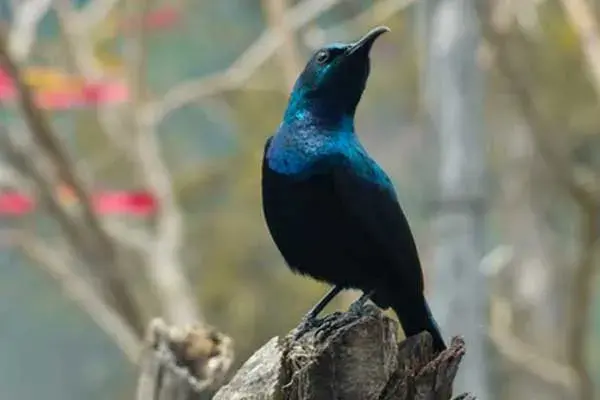
- Scientific name: Cinnyris asiaticus
- Lifespan: 15-20 years
- Wingspan: n/a
- Native to: Southeast Asia
The purple sunbird is a small nectar-feeding bird that can be found in South and Southeast Asia. It displays sexual dimorphism – males and females look different.
The breeding purple sunbird male has a plumage that may appear all black (in low light) or dark metallic blue or purplish-black in better light conditions. The head has a mostly metallic blue and purple color.
Females are olive above, yellowish below, and have a thin yellow supercilium above the eye that looks like an eyebrow.
Read More: Birds That Look Like They Have Eyebrows
These beautiful birds are omnivores and feed on nectar, insects, spiders, and the flesh of fruits and berries. Purple sunbirds are fast fliers and can take nectar by hovering like a hummingbird.
5. Purple Martin
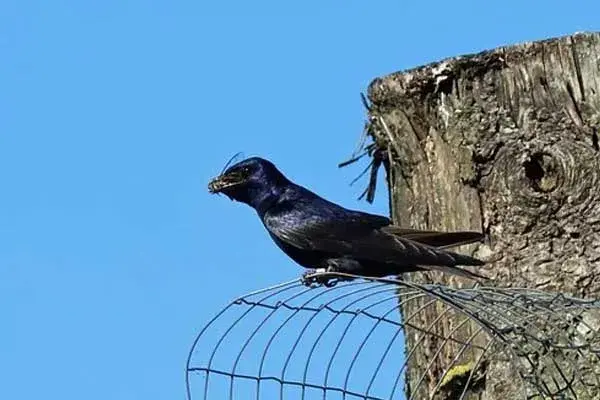
- Scientific name: Progne subis
- Lifespan: 5-7 years
- Wingspan: 15 in
- Native to: North America
Purple Martin is the largest swallow in North America. It has a slightly hooked bill, a short and forked tail, and long, tapered wings.
Adult males are dark overall with a purplish-blue shimmer visible at close range. Depending on the light and angle, their head color may appear to be royal blue, navy blue, deep purple, or even green.
Females are grayer with shine on the crown and back.
Purple martins will typically build their nests out of straw, twigs, and pine needles. They are very social and colonial birds – the largest roosting colony ever discovered had over 700,000 birds!
Purple martins are carnivores (insectivores) that feed on fire ants, bugs, flies, butterflies, dragonflies, grasshoppers, crickets, moths, wasps, bees, cicadas, spiders, and termites.
They are also excellent fliers that can reach flight speeds of over 40 mph.
It is a summer resident in Pennsylvania – check our article about other blue-colored birds in Pa.
6. Rook
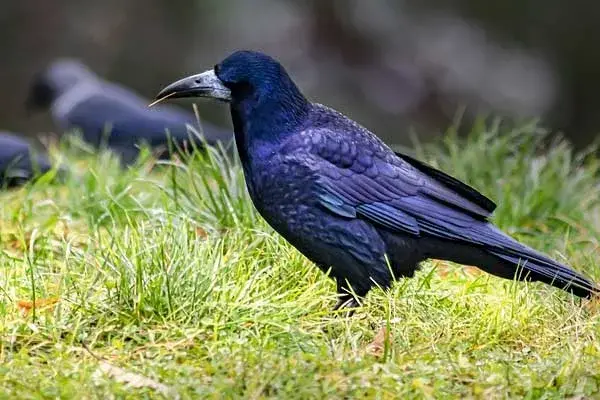
- Scientific name: Corvus frugilegus
- Lifespan: 6 years
- Wingspan: 32-39 in
- Native to: Eurasia and New Zealand
Highly social and quite intelligent, a rook is a large, gregarious, black-feathered bird that has for centuries been considered a bird of both good and bad omens.
The black feathers of the head, neck, and shoulders are dense and silky and will have a blue or bluish-purple sheen in bright sunlight.
The rook is similar in size to the crow but tends to stay away from cities and towns. They mate for life, and both sexes will build a nest of twigs, sticks, dry grass, and dead leaves. Rooks are omnivores and feed on earthworms, small lizards, frogs, bird eggs, and seeds.
7. Tree Swallow
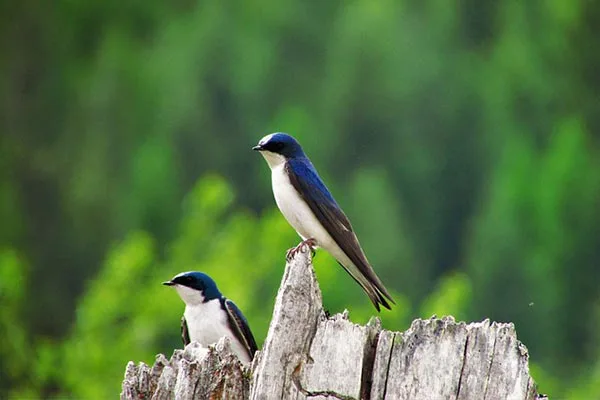
- Scientific name: Tachycineta bicolor
- Lifespan: 3 years
- Wingspan: 12-14 in
- Native to: the United States and Canada
Tree swallows are small migratory songbirds with long, pointed wings and short, squared, or slightly notched tails. Not entirely black, these birds still have an almost metallic greenish-blue back and head, together with a white throat, breast, and belly.
Tree swallows breed in the United States and Canada – they begin migrating south in July and August to western Mexico and Central America. They are social animals with flocks of thousands of birds. Tree swallows are omnivores that feed on insects, mollusks, spiders, and occasionally on fruit, berries, and seeds.
You can see them in Florida, Tennessee, Kansas, Missouri, Ohio, and similar.
8. Asian Fairy-bluebird
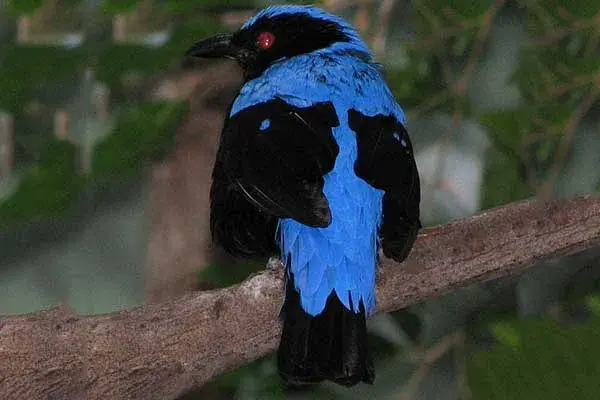
- Scientific name: Irena puella
- Lifespan: n/a
- Wingspan: n/a
- Native to: Southern Asia
The Asian fairy-bluebird or Asian blue-backed fairy bluebird is a medium-sized tree-dwelling bird found in forests across tropical southern Asia. This beautiful bird has a strong black bill and legs, and bright red eyes.
Males have brilliant blue backs while females have duller turquoise ones. The head has the same color as the sky – at times intense blue and at times azure and very bright.
Asian fairy-bluebirds live in pairs or small groups and will hide their nest in the densest and most humid areas of the forest. They are known to use green moss to camouflage their nest and the young.
These blue-headed birds are omnivores that mostly feed on fruits, nectar from flowers, and some insects.
9. Blue-black Grassquit
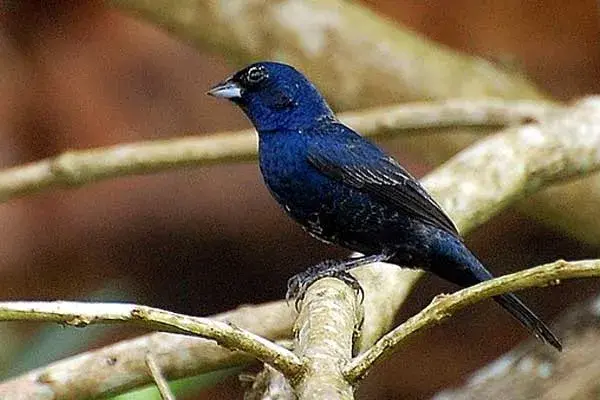
- Scientific name: Volatinia jacarina
- Lifespan: 12 years
- Wingspan: n/a
- Native to: Central and South America
The Blue-black Grassquit is a small black bird native to Central and South America. Males have black plumage on tails and wings, and glossy dark blue heads and backs. Females have brown upperparts.
These grassquits can be found in fields, farmland, and other open grassy areas.
Blue-back grassquit is an omnivore that feeds mainly on seeds, often of the tall grasses on roadsides, but also on small insects.
They are monogamous birds that mate for life – males are known to carry out extended jumping display rituals during the mating season, which gives rise to the local name “johnny jump-up”.
10. Satin Bowerbird
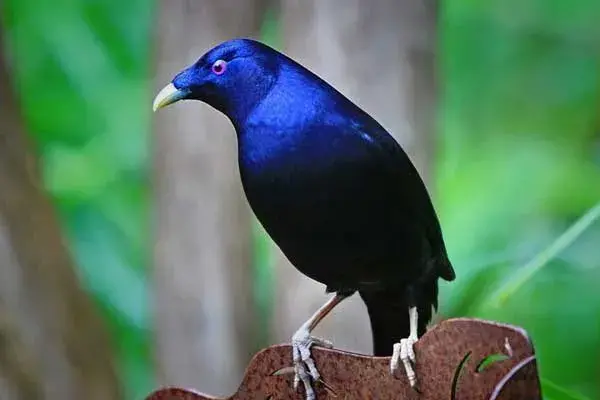
- Scientific name: Ptilonorhynchus violaceus
- Lifespan: 8-9 years (up to 26 years)
- Wingspan: 18-20 in
- Native to: Australia
The satin bowerbird is a medium-sized bowerbird native to eastern Australia. Adult males have an entirely dark glossy blue-purple color with a short pale bill and bright violet eyes.
Many ornithologists consider satin bowerbirds as one of the most advanced since they use tools and mix “paint” to color the walls of their bower (nest-like structure).
Males will create and decorate these structures with attention-getting items. The females will then tour many of these local bowers, assessing both structure and suitor before selecting a mate.
The competition for bower decoration is fierce – many males will steal items from other bowers to improve their own.
If a female finds a bower she likes, she enters its bower, but the mating ritual isn’t over. The male will then need to perform a dance for her while holding a favorite trinket in his beak. These birds for some reason prefer blue-colored items as decoration.
All bowerbirds are frugivores, that mainly feed on the fruits of trees and bushes; occasionally, they eat insects, spiders, and seeds.
11. Blue-black Grosbeak

- Scientific name: Cyanoloxia cyanoides
- Lifespan: 6-7 years
- Wingspan: 11 in
- Native to: Central and South America
The blue-black grosbeaks are songbirds found in pairs in humid evergreen forests and edges in tropical lowlands. They are sexually dimorphic. Females have dark brown plumage with a slight reddish hue.
Males have dark blue plumage with lighter blue eyebrows and shoulder patches on their wings. The forehead also has a lighter shade of blue. Similar to other bluebirds, the blue color is due to the way the light strikes their feathers, it is not pigment coloration.
These birds with blue and black plumage are omnivores and feed on seeds, fruits, insects, snails, and other small invertebrates. Blue-black grosbeaks will sometimes use a shed snakeskin to build their nests.
Read More: 20+ examples of birds that are white and blue
12. Shining Honeycreeper
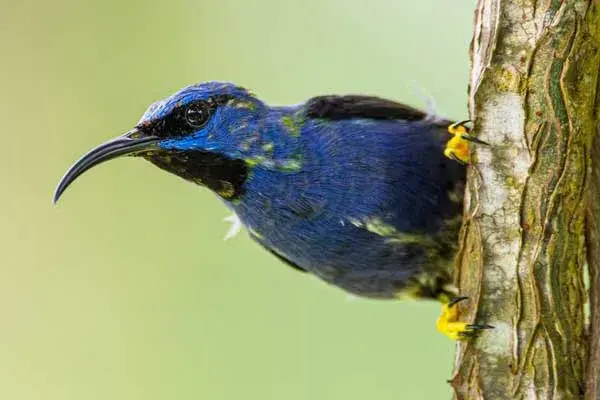
- Scientific name: Cyanerpes lucidus
- Lifespan: 5-12 years
- Wingspan: n/a
- Native to: Central and South America
The shining honeycreeper is a small warbler-like tanager bird found in humid tropical evergreen forests. The male has a long black decurved bill, black wings, tail, and throat. Its head, back, and underparts are purple-blue. The female has green plumage, a greenish-blue head, and bluish underparts. The legs of both are bright yellow.
Shining honeycreepers are omnivores that feed on nectar, berries, and insects, mainly in the canopy.
They are very active birds, and males and females will sing in a duet to maintain their bond.
Looking for more blue-headed birds that are not just black? Check this article.
13. Indigo Bunting
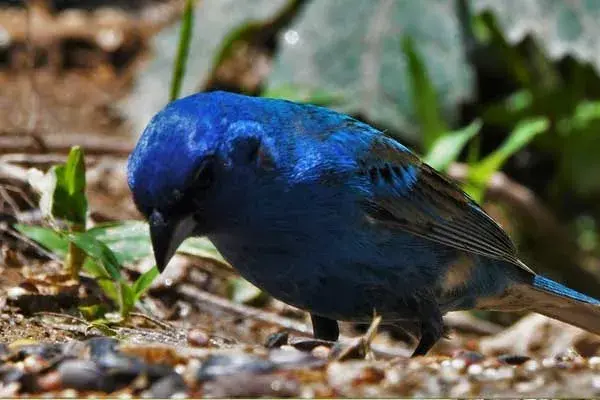
- Scientific name: Passerina cyanea
- Lifespan: 10 years
- Wingspan: 7-9 in
- Native to: Central and North America
The indigo bunting, also known as blue bunting, is a small seed-eating bird found in dense thickets and woodland edges. It is a migratory bird that travels during the night, using stars to navigate.
Adult males have a vibrant blue plumage during summer, with slightly richer blue on their heads. During the winter months, they are brown, just like females, only year-round.
Scientists consider indigo buntings as black birds – because of different light angles hitting their feathers, some birds look blue. They are omnivores and feed on insects, seeds, and berries.
A group of buntings is called a “decoration”, “mural”, or “sacrifice”.
14. Blue-black Kingfisher
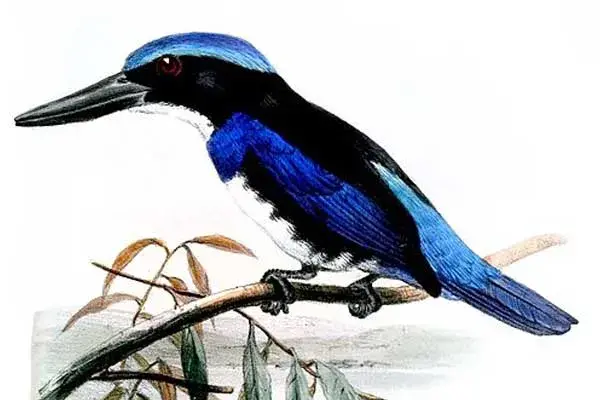
- Scientific name: Todiramphus nigrocyaneus
- Lifespan: 5-10 years
- Wingspan: n/a
- Native to: New Guinea
Blue-back kingfisher is a medium-sized kingfisher with a dark blue head (crown), pale blue eyebrows, black face, and pale blue back becoming darker on the rump and tail.
It is considered very rare and can be found in Papua New Guinea and the adjacent islands of Salawati, Batanta, and Yapen. Blue-back kingfisher is carnivorous and feeds on fish or crabs.
15. Brown Sicklebill
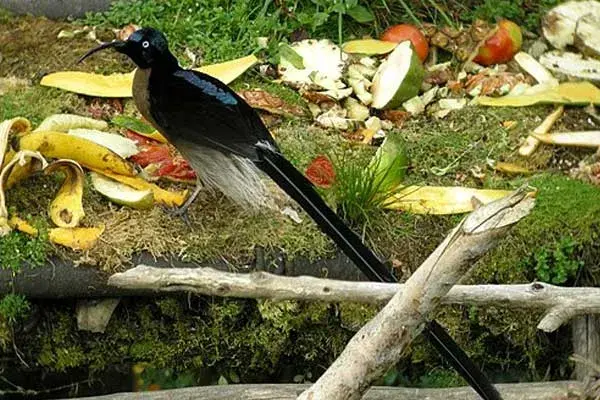
- Scientific name: Epimachus meyeri
- Lifespan: n/a
- Wingspan: n/a
- Native to: New Guinea
The brown sicklebill is a large, long-tailed bird-of-paradise that is found in the mountain forests of New Guinea.
Male brown sicklebills have blue-green feathers, black upperparts, brown breasts, and metallic blue-green feathers. Females are mostly brown.
They are omnivores and mostly feed on fruits and arthropods and insects.
Read More: 40+ examples of birds that have orange beaks
16. Blue-necked Tanager
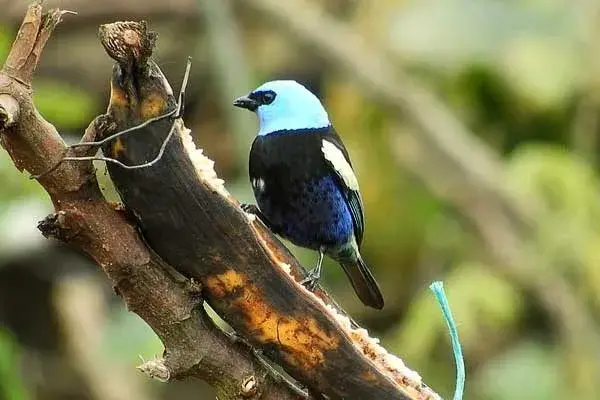
- Scientific name: Tangara cyanicollis
- Lifespan: n/a
- Wingspan: n/a
- Native to: South America
The blue-necked tanager is a small bird, often seen flying in the subtropical or tropical lowland forests of South America. It is easy to spot by its brilliant blue head, black back, and turquoise rump (back of the lower back). The underparts are black, violet, and blue.
Although they mostly feed on fruits, berries, and flower blossoms, blue-necked tanglers will also catch insects in mid-flight.
After breeding, the female will build a nest of moss, and conceal it well. It will usually lay 2 white eggs with brown spottings.
17. Superb Fairywren
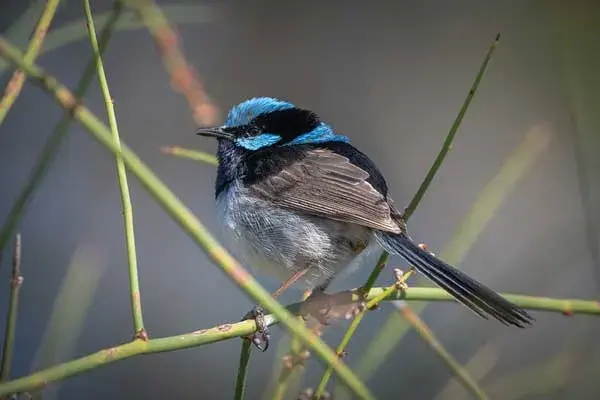
- Scientific name: Malurus cyaneus
- Lifespan: 5 years
- Wingspan: 4.7-6.3 in
- Native to: Southeast Australia
Superb fairy-wrens, with their glorious blue head color, can be seen perched high on bare branches surveying their territories. They were one of the first described Australian birds.
When the breeding season comes, superb fairywrens are one of the most brightly colored species. During that period, their sky-blue-colored caps become iridescent. They also have dark brown legs.
Super fairywrens are socially monogamous but sexually promiscuous; the males are said to be ‘the least faithful birds in the world’. Around 76% of the offspring are sired by males from outside the social group – they are the result of some avian ‘cheating’.
Still, these birds will form pairs between one male and one female.
Fairywrens mostly feed on the ground, eating insects, including grasshoppers, ants, larvae, small seeds, and fruits.
18. Southern Cassowary
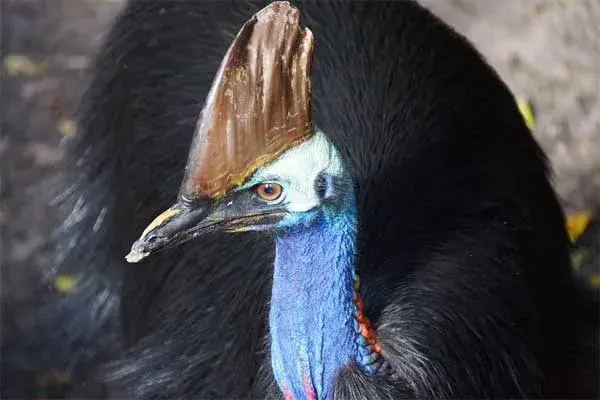
- Scientific name: Casuarius casuarius
- Lifespan: 20-40 years
- Wingspan: n/a
- Native to: Indonesia, Papua New Guinea, and northeastern Australia
Southern cassowaries are huge prehistoric-looking birds with glossy black plumage, tall, brown casques (helmets) on top of their deep blue heads, and long drooping red wattles.
Their habitat mostly includes tropical rainforests, and occasionally savannah forests of Indonesia, Papua New Guinea, and northeastern Australia.
Southern cassowaries can’t fly as they have extremely small wings. However, they can grow almost 6 ft tall and weigh up to 187 pounds.
Southern cassowaries are the third heaviest bird in the world, after the Somali and common ostrich.
They are one of the closest relatives of the dinosaurs, as well.
Wildlife biologists call cassowaries the world’s most dangerous birds; they have killed people with their sharp 5-inch-long claws.
Southern cassowaries are omnivores that mainly feed on fruit, berries, fungi, rodents, snails, lizards, and occasionally their poop (it is made of half-digested fruit which has nutritional value). They can also eat up to 11 pounds of fruit a day!
19. Black-throated Blue Warbler
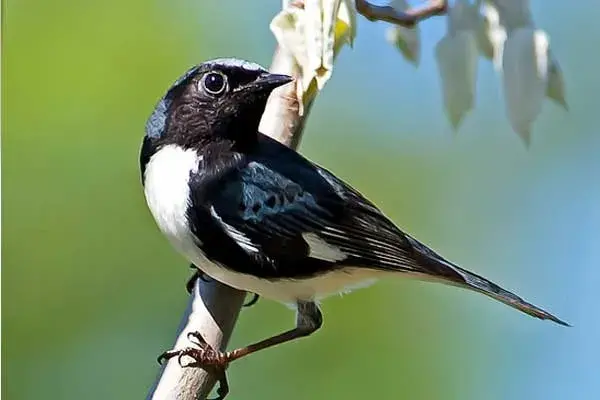
- Scientific name: Setophaga caerulescens
- Lifespan: up to 10 years
- Wingspan: 7.5 in
- Native to: North America
Black-throated blue warblers are small, well-proportioned blue birds with sharp, pointed beaks. They breed in dense hardwood forests of the northeastern United States and eastern Canada.
Males have a deep midnight blue color above, on their heads and backs, white bellies, and black faces and sides. They do not change their appearance as the season changes; black-throated blue warblers can be easily recognized in the fall and the spring.
When first discovered, since males and females look so different, people used to describe them as two separate species.
Black-throated blue warblers are cute-looking and very small songbirds weighing just 0.34 oz.
They feed on insects, especially caterpillars, moths, crane flies, and also spiders. They might occasionally supplement their insectivorous diet with some fruit.
Further Reading: More examples of black birds that have bright red wings
20. Black Grouse
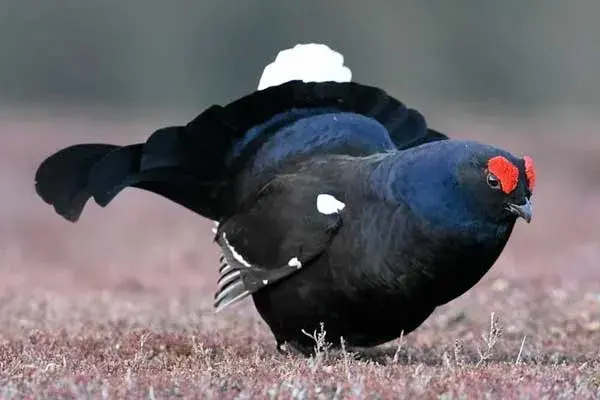
- Scientific name: Lyrurus tetrix
- Lifespan: 5 years
- Wingspan: 25-31.5 in
- Native to: Europe
Black grouses are large sedentary black birds with blue heads.
Males have black plumage and a distinctive red wattle over the eye that resemble thick and bushy eyebrows. They are also recognized for their tail which has a shape of a lyre and appears forked in flight.
Black grouse can be found across Europe in groups; they migrate to dense forests in large flocks.
Read More: 25+ examples of orange and blue birds
Final Thoughts
Blackbirds are a big group of birds that include over 100 species (109 to be precise). Three of those have black plumage and blue color of their heads: common grackle, black oropendola, and shiny cowbird.
Examples of black birds with blue heads include purple martins, blue-black grassquits, shiny cowbirds, purple sunbirds, southern cassowaries, and many others.
We hope you found our list of blackbirds with blue heads interesting, and that you might be able to recognize them next time you go birdwatching.
And if you are interested in learning more about black birds that have white spots, check out this article.
If you want to learn more about black birds with orange beaks, check out this article.